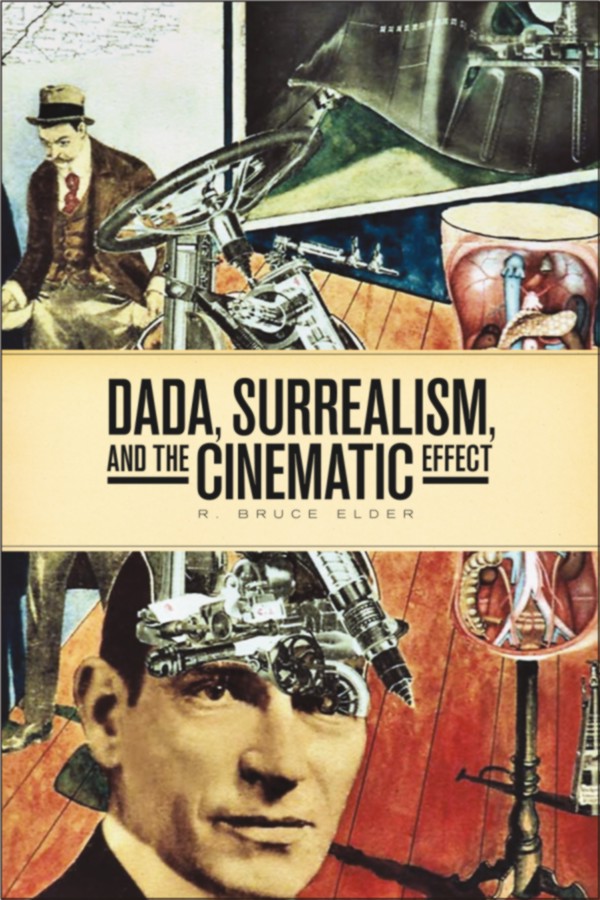R. Bruce Elder: Dada, Surrealism, and the Cinematic Effect (2013)
Filed under book | Tags: · alchemy, art history, avant-garde, chance, cinema, collage, consciousness, dada, dreams, film, film history, language, mathematics, occultism, sexuality, spiritualism, surrealism, theory

“This book deals with the early intellectual reception of the cinema and the manner in which art theorists, philosophers, cultural theorists, and especially artists of the first decades of the twentieth century responded to its advent. While the idea persists that early writers on film were troubled by the cinema’s lowly form, this work proposes that there was another, largely unrecognized, strain in the reception of it. Far from anxious about film’s provenance in popular entertainment, some writers and artists proclaimed that the cinema was the most important art for the moderns, as it exemplified the vibrancy of contemporary life.
This view of the cinema was especially common among those whose commitments were to advanced artistic practices. Their notions about how to recast the art media (or the forms forged from those media’s materials) and the urgency of doing so formed the principal part of the conceptual core of the artistic programs advanced by the vanguard art movements of the first half of the twentieth century. This book, a companion to the author’s previous, Harmony & Dissent, examines the Dada and Surrealist movements as responses to the advent of the cinema.”
Publisher Wilfrid Laurier University Press, Waterloo, 2013
Film and Media Studies series
ISBN 9781554586257, 1554586259
x+765 pages
Reviews: John W. Locke (Canadian J of Film Studies 2014), Robin Walz (Canadian J of History 2014), Bart Testa (U Toronto Quarterly 2015).
PDF (8 MB, updated on 2019-12-14)
EPUB (added on 2019-12-14)
Anselm Franke (ed.): Animism, 1 (2010)
Filed under book | Tags: · aesthetics, animal, animism, art, art history, ethnography, film, nature, spiritualism, things

“What is the role of aesthetic processes in the drawing of the boundaries between nature and culture, humans and things, the animate and inanimate? Structured around the aesthetic processes and effects of animation and mummification, Animism—a companion publication to the long-term exhibition of the same title, which premiered at Extra City Kunsthal Antwerpen in January 2010—brings together artistic and theoretical perspectives that reflect on the boundary between subjects and objects, and the modern anxiety that accompanies the relation between “persons” and “things.”
With works by Agency, Art & Language, Christian W. Braune & Otto Fischer, Marcel Broodthaers, Paul Chan, Tony Conrad, Didier Demorcy, Walt Disney, Lili Dujourie, Jimmie Durham, Eric Duvivier, Harun Farocki, León Ferrari, Christopher Glembotzky, Victor Grippo, Brion Gysin, Luis Jacob, Ken Jacobs, Darius James, Joachim Koester, Zacharias Kunuk, Louise Lawler, Len Lye, Étienne-Jules Marey, Daria Martin, Angela Melitopoulos & Maurizio Lazzarato, Wesley Meuris, Henri Michaux, Santu Mofokeng, Vincent Monnikendam, Tom Nicholson, Otobong Nkanga, Reto Pulfer, Félix-Louis Regnault, Józef Robakowski, Natascha Sadr Haghighian, Paul Sharits, Yutaka Sone, Jan Švankmajer, David G. Tretiakoff, Rosemarie Trockel, Anne-Mie Van Kerckhoven, Dziga Vertov, Klaus Weber, Apichatpong Weerasethakul.”
With contributions by Agency, Irene Albers, Oksana Bulgakowa, Edwin Carels, Bart De Baere, Didier Demorcy, Brigid Doherty, Sergei Eisenstein, Anselm Franke, Masato Fukushima, Avery F. Gordon, Richard William Hill, Darius James, Gertrud Koch, Joachim Koester, Bruno Latour, Maurizio Lazzarato and Angela Melitopoulos, Vivian Liska, Henri Michaux, Santu Mofokeng, Philippe Pirotte, Florian Schneider, Erhard Schüttpelz, Michael Taussig, Eduardo Viveiros de Castro, Martin Zillinger.
Publisher Sternberg Press, Berlin, with Extra City – Kunsthal Antwerpen and M HKA – Museum of Contemporary Art, Antwerp, 2010
ISBN 9781933128955
256 pages
via chickpou
PDF (7 MB, updated on 2019-1-15)
Exhibition booklets: Muhka (EN), Muhka (NL), HKW (EN), HKW (DE).
Louis Kaplan: The Strange Case of William Mumler, Spirit Photographer (2008)
Filed under book | Tags: · 1860s, hauntology, photography, psychoanalysis, spirit photography, spiritualism

In the 1860s, William Mumler photographed ghosts—or so he claimed. Faint images of the dearly departed lurked in the background with the living, like his well-known photo of the recently assassinated Abraham Lincoln comforting Mary Todd. The practice came to be known as spirit photography, and some believed Mumler was channeling the dead. Skeptics, however, called it a fraudulent trick on the gullible, taking advantage of the grieving at a time of suffering and loss. Mumler’s insistence that his work brought back the dead led to a sensational trial in 1869 that was the talk of the nation.
In The Strange Case of William Mumler, Spirit Photographer, Louis Kaplan brings together, for the first time, Mumler’s haunting images, his revealing memoir, and rich primary sources, including newspaper articles and P. T. Barnum’s famous indictment of Mumler in Humbugs of the World. Kaplan also contributes two extended essays, which offer a historical perspective of the Mumler phenomena and delve into the sociocultural and theoretical issues surrounding this vivid ghost story.
Mumler’s case was an early example of investigative journalism intersecting with a criminal trial that, at its essence, set science against religion. The Strange Case of William Mumler, Spirit Photographer is the definitive resource for this unique and fascinating moment in American history and provides insights into today’s ghosts in the machine.
Publisher University of Minnesota Press, 2008
Fesler-Lampert Minnesota Heritage Books
ISBN 0816651566, 9780816651566
288 pages

